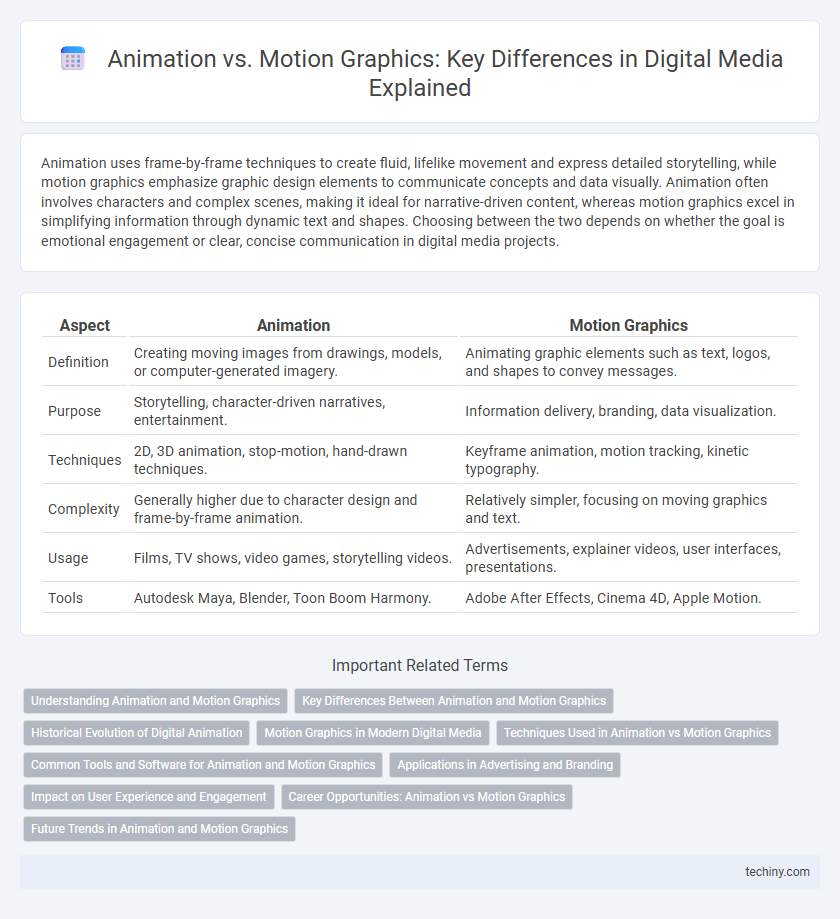Animation uses frame-by-frame techniques to create fluid, lifelike movement and express detailed storytelling, while motion graphics emphasize graphic design elements to communicate concepts and data visually. Animation often involves characters and complex scenes, making it ideal for narrative-driven content, whereas motion graphics excel in simplifying information through dynamic text and shapes. Choosing between the two depends on whether the goal is emotional engagement or clear, concise communication in digital media projects.
Table of Comparison
| Aspect | Animation | Motion Graphics |
|---|---|---|
| Definition | Creating moving images from drawings, models, or computer-generated imagery. | Animating graphic elements such as text, logos, and shapes to convey messages. |
| Purpose | Storytelling, character-driven narratives, entertainment. | Information delivery, branding, data visualization. |
| Techniques | 2D, 3D animation, stop-motion, hand-drawn techniques. | Keyframe animation, motion tracking, kinetic typography. |
| Complexity | Generally higher due to character design and frame-by-frame animation. | Relatively simpler, focusing on moving graphics and text. |
| Usage | Films, TV shows, video games, storytelling videos. | Advertisements, explainer videos, user interfaces, presentations. |
| Tools | Autodesk Maya, Blender, Toon Boom Harmony. | Adobe After Effects, Cinema 4D, Apple Motion. |
Understanding Animation and Motion Graphics
Animation involves creating the illusion of movement by displaying a sequence of images or frames, often incorporating characters and storytelling elements to convey narratives. Motion graphics primarily focus on graphic design elements like text, shapes, and visual effects to communicate information or enhance user interfaces without relying on character-driven stories. Understanding the distinction between animation and motion graphics is essential for selecting the appropriate technique in digital media projects, as animation emphasizes dynamic storytelling while motion graphics prioritize visual communication and brand messaging.
Key Differences Between Animation and Motion Graphics
Animation involves creating detailed, frame-by-frame sequences that bring characters and stories to life, often used in films and video games. Motion graphics focus on animated graphic design elements like text, shapes, and logos, primarily utilized for marketing, presentations, and user interfaces. While animation emphasizes narrative and character development, motion graphics prioritize visual communication and brand messaging.
Historical Evolution of Digital Animation
The historical evolution of digital animation traces back to the 1960s when early computer graphics were developed, leading to the first vector-based animations. The 1980s marked a significant breakthrough with the introduction of CGI technology in films, exemplified by Disney's pioneering use of CAPS for digital ink and paint. Motion graphics evolved alongside animation, emphasizing graphic design elements and typography while benefiting from advancements in digital animation software such as Adobe After Effects.
Motion Graphics in Modern Digital Media
Motion graphics play a pivotal role in modern digital media by combining graphic design, animation, and audio to create engaging visual content for branding, advertising, and user interfaces. Unlike traditional animation, motion graphics primarily emphasize abstract shapes, text, and data visualization to communicate complex ideas quickly and effectively. Industries such as marketing, film production, and social media rely heavily on motion graphics to enhance storytelling and capture audience attention in an increasingly digital landscape.
Techniques Used in Animation vs Motion Graphics
Animation techniques often involve frame-by-frame drawing, keyframing, and rigging to create fluid character movements and storytelling sequences. Motion graphics primarily utilize vector-based tools, shape layers, and keyframe animations to design dynamic text, logos, and abstract visual effects. Both fields employ software like Adobe After Effects, but animation emphasizes complex character rigs while motion graphics focus on smooth transitions and graphic elements.
Common Tools and Software for Animation and Motion Graphics
Adobe After Effects and Blender are among the most common tools used for both animation and motion graphics, offering extensive features for creating dynamic visuals. Toon Boom Harmony specializes in traditional frame-by-frame animation, while Cinema 4D excels in 3D motion graphics and complex animations. Tools like Adobe Animate focus on vector-based animations, making it a popular choice for web animations and interactive media.
Applications in Advertising and Branding
Animation in digital media utilizes character-driven narratives and detailed visuals to create emotional connections, making it ideal for storytelling in advertising campaigns and brand mascots. Motion graphics emphasize dynamic text, shapes, and visual effects to communicate messages quickly and clearly, often used in explainer videos, logo animations, and social media ads. Both techniques enhance brand recognition and engagement by tailoring visual content to target audience preferences and platforms.
Impact on User Experience and Engagement
Animation enhances user experience by delivering immersive storytelling through fluid character movements and detailed visual narratives, fostering emotional connections. Motion graphics prioritize clarity and information delivery with dynamic text and graphic elements, boosting engagement by simplifying complex data and guiding user attention. Combining both techniques creates an interactive digital media environment that maximizes engagement and retention rates.
Career Opportunities: Animation vs Motion Graphics
Animation offers diverse career opportunities in film, television, video games, and virtual reality, emphasizing character design, storyboarding, and 3D modeling skills. Motion graphics careers focus on advertising, social media content, and user interface design, requiring expertise in graphic design, typography, and software like Adobe After Effects. Both fields demand creativity and technical proficiency but cater to different industries and project types, influencing job roles and market demand.
Future Trends in Animation and Motion Graphics
Emerging technologies such as artificial intelligence and real-time rendering are revolutionizing animation and motion graphics by enabling more personalized and interactive digital experiences. The integration of augmented reality (AR) and virtual reality (VR) is driving demand for immersive content that blends animation with motion graphics in innovative ways. Advances in cloud-based collaboration platforms and machine learning algorithms are streamlining production workflows, allowing creators to produce high-quality animations and motion graphics faster and more efficiently.
Animation vs Motion Graphics Infographic

 techiny.com
techiny.com